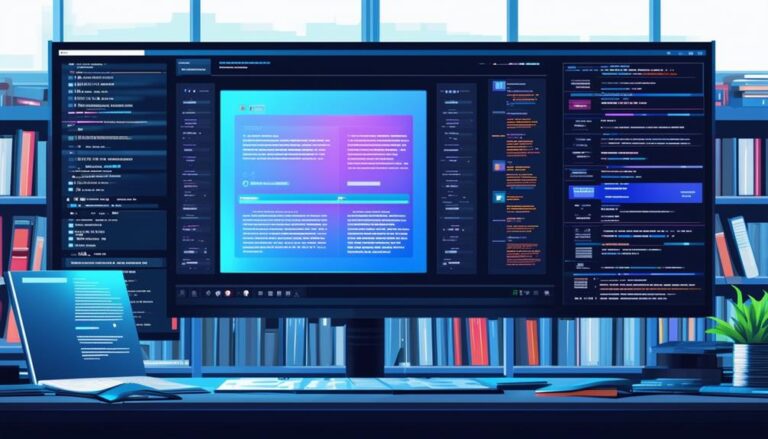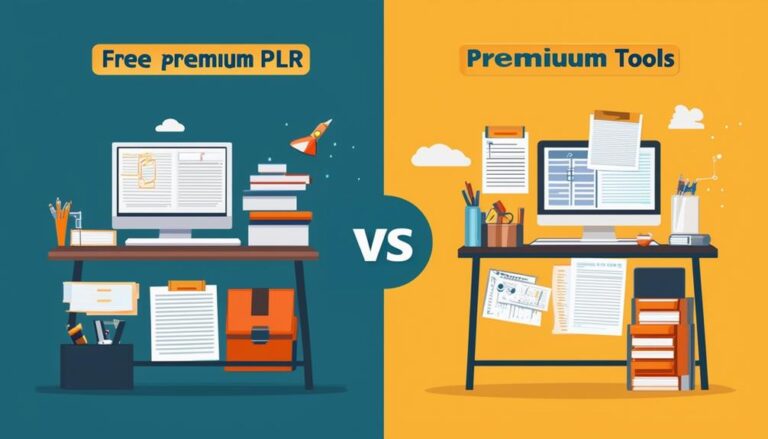Guide to Customizing PLR Software Products"
When customizing PLR software products, you'll begin by understanding the licensing terms, ensuring you comply with legal stipulations and can maximize the product's potential. Use essential tools like code editors to make precise amendments, enhancing code efficiency through refactoring while focusing on areas that improve overall functionality. Transform user interfaces by updating color schemes and icons, aligning aesthetics with your brand, and increasing user engagement. Add unique features that fulfill specific user needs, and rigorously debug and test to maintain quality. Rebrand to reflect your distinct identity, stimulating customer loyalty and market positioning. As you explore these steps further, consider how each enhancement impacts your software's appeal in your specific market.
Quick Rundown
- Review PLR software licenses to ensure modifications are legally permissible.
- Utilize code editors and version control systems for efficient customization.
- Enhance user interfaces to improve aesthetics and user experience.
- Add new features that meet the specific needs of your target audience.
- Conduct thorough debugging and testing to ensure functionality and reliability.
Understanding PLR Software Licenses
Before you use or modify any PLR (Private Label Rights) software, it's important to fully understand its licensing terms.
When you're part of a community that customizes PLR products, knowing the specifics about license exclusivity and renewal terms is vital. License exclusivity determines whether you can sell the software as your own exclusive product or if others may also use it. This impacts how unique your offering might be in the market.
Additionally, understanding renewal terms is essential because it affects how long you can use or sell the software before needing to renew the license. Making sure you're clear on these details ensures you're legally compliant and maximizes your membership in this community.
Essential Software Tools for Editing
To effectively customize your PLR software, you'll need to equip yourself with the right editing tools. A vital part of your toolkit should be code editors. These specialized tools offer features like syntax highlighting and auto-completion, making it easier to read and write code efficiently.
You're not alone in this; everyone in this field uses them, ensuring you're part of a community that values precision and effectiveness.
Additionally, version control systems are indispensable. They allow you to track changes, revert to previous versions, and collaborate with others seamlessly. This isn't just about keeping your work safe—it's about being part of a collective that values progress and teamwork.
With these tools, you're well on your way to successfully modifying PLR software.
Modifying Source Code Basics
Once you've equipped yourself with the necessary tools, the next step is to start modifying the source code of your PLR software. It's essential you understand the basics of programming principles. This knowledge won't only help you make effective changes but also guarantee you're enhancing the software's functionality rather than impairing it.
Begin by identifying sections of the code that require improvement or customization. Code refactoring is your ally here; it involves restructuring existing code without changing its external behavior, aiming for cleaner and more efficient code execution. By applying these principles, you'll make the software truly yours, fitting perfectly into the niche you're targeting.
Customizing User Interfaces
After mastering the basics of modifying source code, you'll find that customizing the user interfaces can greatly enhance user experience. By tweaking color schemes and icon redesigns, you're not just altering aesthetics; you're embracing an essential part of creating an inviting environment for your users, making them feel right at home with your software.
Choosing the right color schemes can greatly impact how users perceive your application. Opt for colors that align with your brand and are visually appealing to guarantee a cohesive look.
Similarly, thoughtful icon redesigns can make navigation more intuitive, helping users find their way around your software effortlessly. These changes, while seemingly small, can make a substantial difference in user satisfaction and retention.
Adding New Features and Functions
You'll greatly enhance your software's value by adding new features and functions tailored to meet user needs. Start with feature prioritization, which involves identifying the enhancements most desired by your community.
This isn't just about adding what's trendy; it's about incorporating functions that resonate with your users, creating a sense of belonging and loyalty. Once you've identified these key features, the next step is function integration.
This means seamlessly weaving these new features into the existing framework of your software. It's essential that these additions not only expand the capabilities of your software but also maintain, or ideally improve, the user experience.
Debugging and Testing Adjustments
Having added new features to your software, it's now time to debug and test these adjustments to guarantee they function seamlessly.
As a key member of this creative community, you're not just tweaking a program; you're enhancing a shared tool that countless others could rely on.
Start by setting performance benchmarks. These metrics will help you measure the software's efficiency and responsiveness under various conditions.
Next, integrate robust error reporting mechanisms. This will allow you to capture and analyze any issues that arise, making it easier to pinpoint where the adjustments mightn't be aligning with the existing framework.
Rebranding Your PLR Software
Now that your software is running smoothly, it's time to focus on rebranding your PLR product to make it uniquely yours. A rebrand involves more than just tweaking; it's about creating an identity that resonates with your community.
Start with a logo redesign. Your logo is often the first impression users have, so make sure it aligns with the new image and values you want to project.
Next, consider your price strategy. This isn't just about setting a cost; it's about positioning your product in the market to attract your ideal customers. Think about what pricing will make members feel they're getting great value, encouraging loyalty and spreading the word about your revamped software.
Ensuring Legal Compliance
After rebranding your PLR software, it's important to make sure all aspects of your product comply with legal standards. You're not just building a product; you're joining a community of developers and entrepreneurs who value integrity and responsibility.
Begin by examining copyright considerations first. Confirm you've obtained the right to modify and resell the software under its new name.
Next, align your product with all relevant regulatory standards. These aren't just bureaucratic hurdles; they're safeguards that protect you and your users, ensuring that your software meets the highest levels of safety and quality.
Marketing Your Customized Software
Once your customized software is legally compliant, you'll need to develop a strategic marketing plan to effectively reach your target audience. Start by diving deep into target audience analysis. Understand who needs your software the most and why they'd choose your solution over others.
This understanding will forge a sense of belonging among your users, making them feel like part of a community tailored just for them.
Next, refine your pricing strategies. Consider various tiers that reflect different levels of usage or features that cater to specific needs within your community.
This approach not only makes your product accessible to a broader range but also enhances the feeling of inclusion, as everyone finds something that's just right for them.
Frequently Asked Questions
Can I Use PLR Software for Creating Mobile Apps?
Yes, you can use PLR software for creating mobile apps, but you'll need to verify the license limitations and confirm platform compatibility. It's a great way to feel connected and contribute creatively!
Are There Any PLR Software for Mac Users?
Yes, there are PLR software options available that offer Mac compatibility. You'll find they often come with a user-friendly interface, making it easier for you to feel connected and engaged with your projects.
How Do I Handle Customer Support for Modified PLR Software?
To handle customer support for modified software, you'll need a robust support strategy. Establish clear feedback channels where users feel heard and supported. This approach fosters community and guarantees you're meeting their needs effectively.
What Is the Average Cost to Customize a PLR Software?
The average cost to customize PLR software varies, depending on the customization scope and the development expertise required. You'll likely spend between a few hundred to several thousand dollars to make it truly yours.
Can PLR Software Be Integrated With Third-Party Apis?
Yes, you can integrate PLR software with third-party APIs, but you'll face API compatibility and integration challenges. It's important to confirm the software supports these extensions to meet your community's needs.
Conclusion
Now that you're equipped with the basics of customizing PLR software, you can modify source codes, enhance interfaces, and add new features with confidence.
Remember, it's important to stay compliant with legal standards while rebranding and marketing your software. Regular debugging and testing will guarantee your product remains reliable.
By applying these strategies effectively, you'll not only personalize your software but also potentially increase its market appeal and value.






